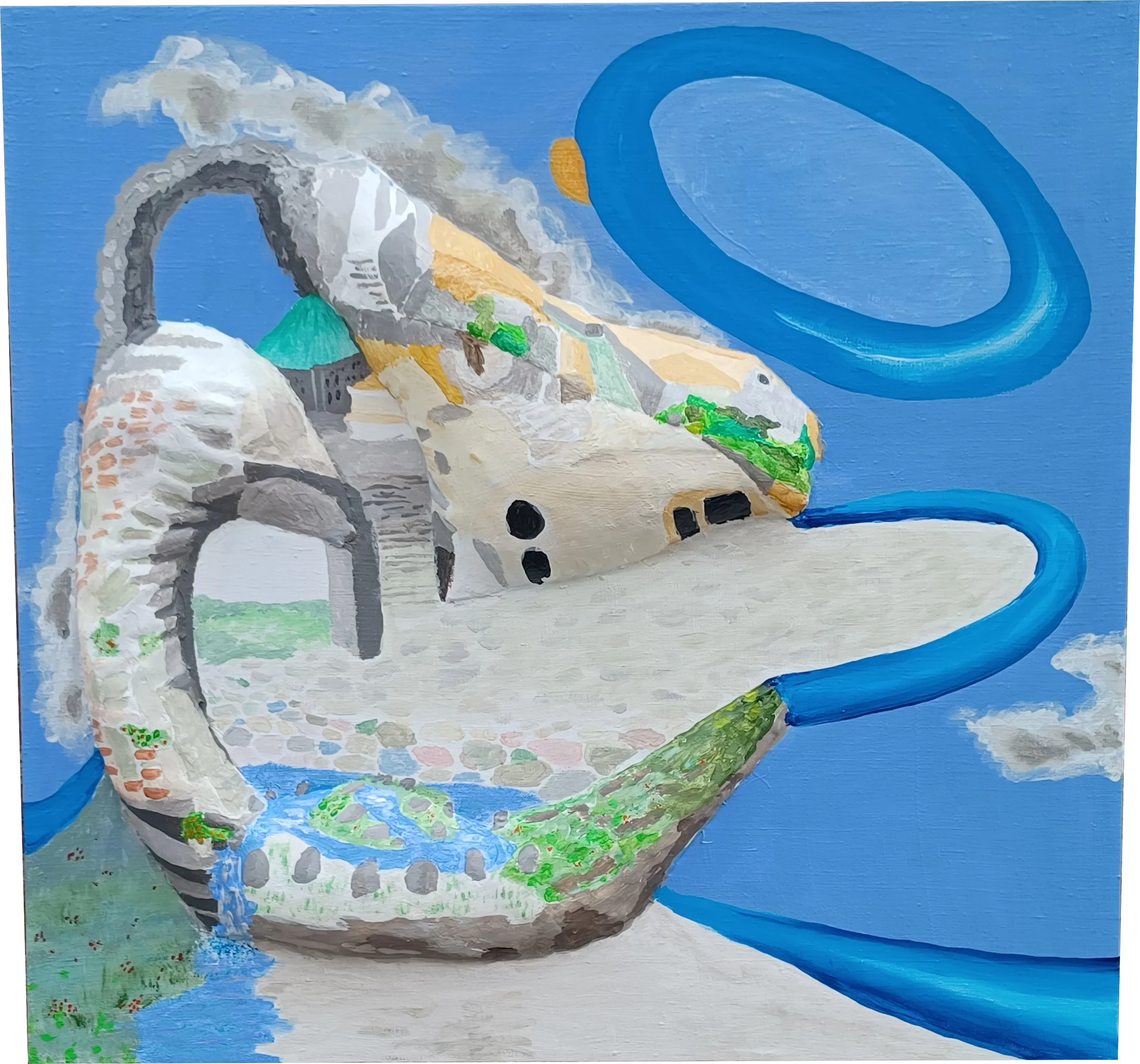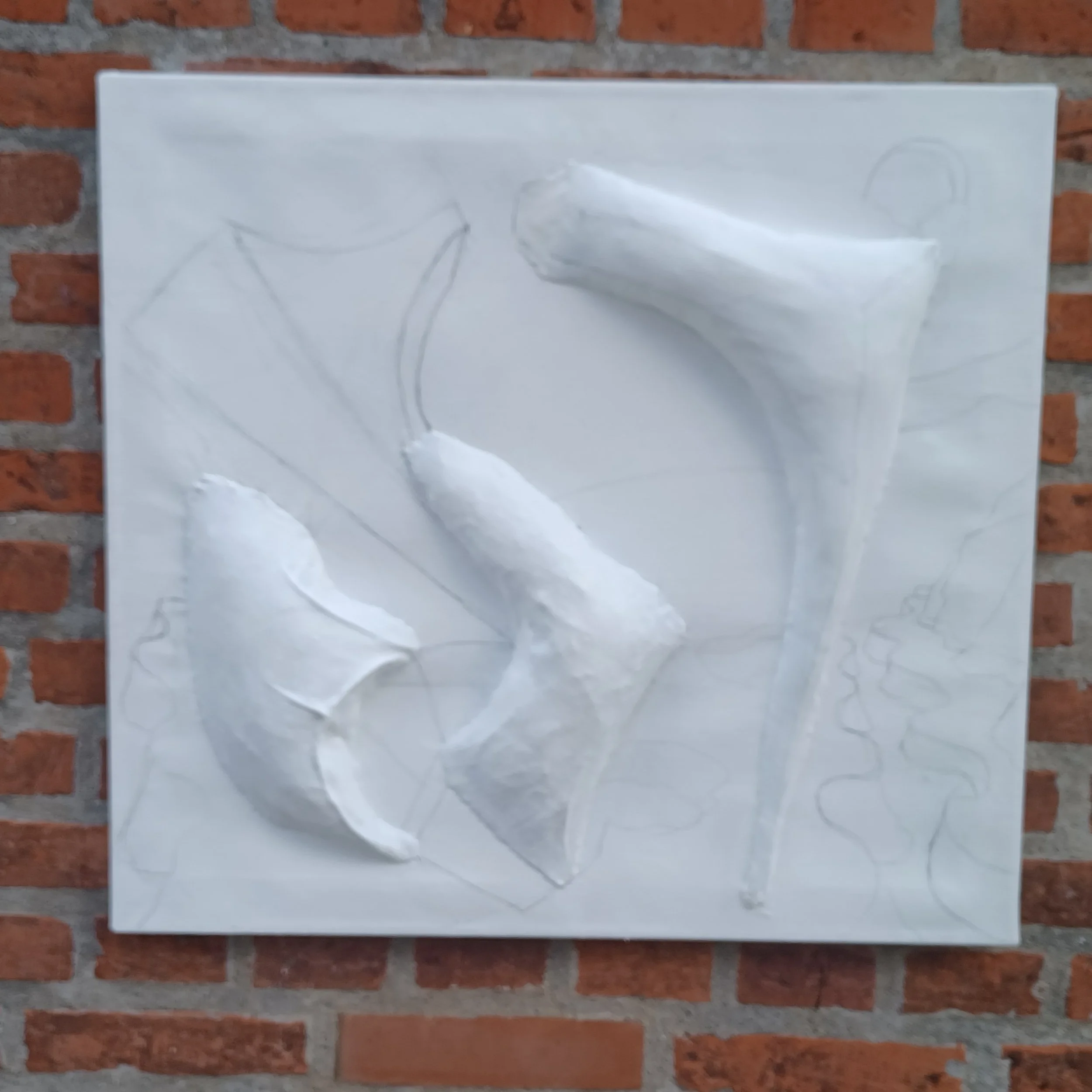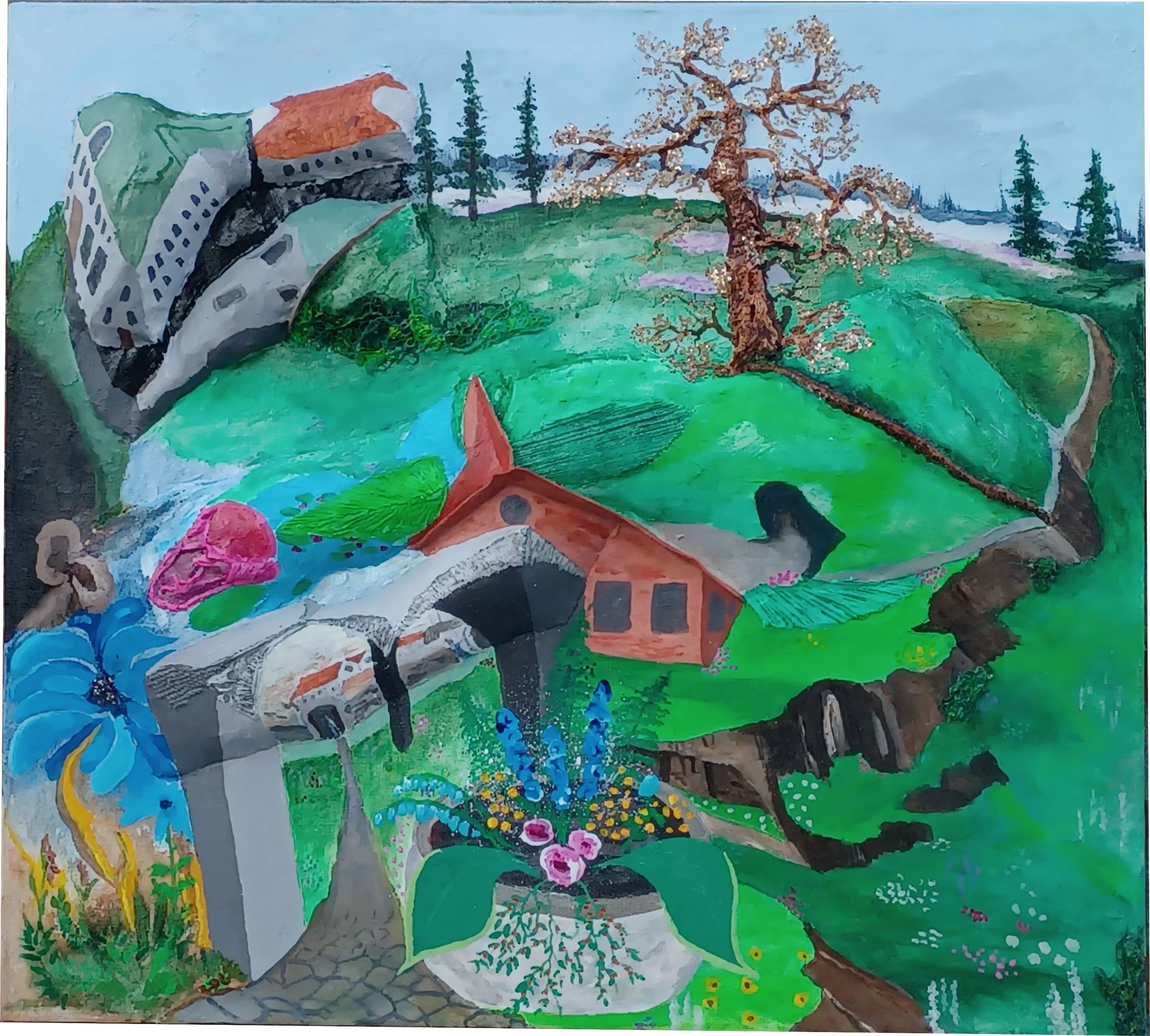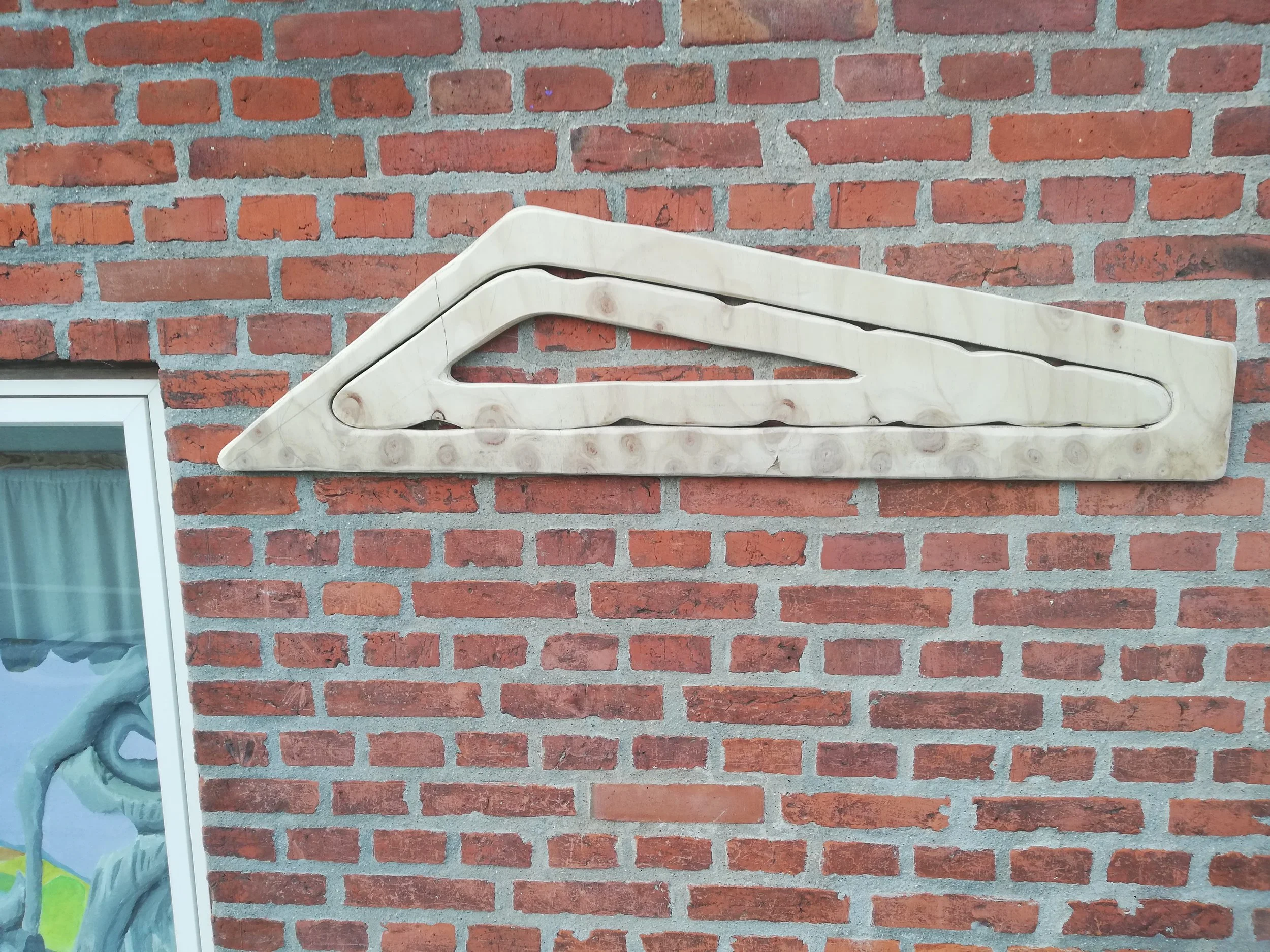Interview with A.C.Rosmon
I came to think of ...
To me there is something strange about us taking everything apart. sculptures are in materials that have their original color, and paintings are flat and square. we look at beautiful Greek sculptures, and have learned that it was real art. Although science has found that the Greek and the Egyptian sculptures were colorful, it is not news that has gotten far. When we look at flowers and beautiful birds, they are things in physical 3-D with lots of rich colors. Are we as artists too lazy, so that instead of a full-scale orchestral work for a full symphony orchestra, we settle for a campfire song, and if we do it big, then maybe a chamber concert. I know that the world is complex and that it is impossible to see everything at once, I have made too many gardens for that, and spent too much time in nature where we can often see far. Why not surround us with art that, like nature, changes, and where it matters where things are shown from, and where we can argue about how long a bridge is, because we see things from different sides. What about surrounding ourselves with art that can satisfy?
I know that creating a 3-D canvas from scratch is a lot of work. Stretching a canvas is nothing special to me, since I have stretched thousands of canvases since I started painting, and with a staple gun everything has become much easier. Only when there are internal angles does it get a little more complicated, and it often does when we must work in 3-D. Sewing work in particular takes time, and a good finish is important, and must usually be adjusted in several rounds.
For me, there are several advantages, because it gives peace of mind, and I like the work where the formal mathematics ceases and where the bodily mathematics begins to function, and where the right hemisphere of the brain takes over and time disappears. Hands, eyes and brain work together, and organically a result arises which can be exciting in itself, and when the preparation and gesso have been applied, it can in principle be exhibited as a work of art, as another relief or sculpture.
Now the magic begins, when the colors enhance the sculptural expression, and a sweet story begins to turn into an adventure with both people and other creatures. We don't always see those who live, but there are always signs that there must be someone living a little hidden here.
Allow yourself to be curious, because the more curious you are, the more you get for your money. I was born curious. I was pretend dead at birth, probably because I want to be in several worlds at once, and in a way, we always are in the world we live in now, plus something more. We are in one world, but are simultaneously influenced by what is on the computer, what is in the newspaper, and the magazine on the table, the books on the bookshelf, and what we see on television; and then the phone rings...
There is a big fight which was sent down to earth. 1/3 of the angels were thrown out of heaven, and it can sometimes be difficult to find out if they are God's Angels, or if they are those who followed Lucifer, who try to interfere when I paint. I'm pretty sure that someone interferes sometimes. That the Angels of God mix, I am quite sure, because I have seen some places that do not belong to our earth, because there the vibrations are quite different. at the same time, I also have something that dark beings have shown me. Things are sometimes a bit complicated.
Finding a good work for your home is just as demanding as it is demanding of us artists to make a good work of art.
How has your diverse background, including training as a dyehouse- and chemistry assistant, influenced your artistic process and choice of materials?
When I started painting in 1969, there were only oil artists' colors. On a Danish brand, the chemical name of the dye was on the tube, so I chose that brand. While I was at the textile school, I gained extensive material knowledge of textiles and their properties, and knowledge of what they can withstand. Here I also learned the basics of mixing colors.
At my apprenticeship there was a German color master who said that if you mix 2 colors and they not, are really good friends, they start eating each other, and if they hate each other, they try to kill each other. This means that I am relatively certain that I have well over 1,000 colors and the like to paint with. I think it will be difficult to find someone in Denmark who knows more about acrylic techniques than me, and I wonder if there are others in the world who have made such different types of canvases as I have.
Can you describe a pivotal moment or a significant influence in your journey from being an autodidact artist in 1969 to becoming state-recognized with multiple censored exhibitions?
I have a habit of getting crazy ideas, and one day I had the idea: if you could make a canvas that was physics 3-D, then you had to be able to make a work that you can't just paint yourself out of, so that's why I started looking for a recipe on how to prepare canvases. I got a recipe and then I started to develop it with the physical 3-D, and it paid off.
How do your experiences as a shaping teacher in primary and independent schools reflect in your artwork or your approach to art?
When you are not afraid to teach what you know something about, you become even more skilled, and often a teacher can learn as much as your students if you don't have the attitude that I know everything worth knowing. I can often see what mistakes my students make, and this can often be fertile ground for ideas to develop new ones.
You've exhibited your work extensively, both in Denmark and abroad. Which exhibition or venue has been most impactful for your career and why?
Apart from the fact that the State-recognized Censored Exhibitions give you access to even better exhibition venues, all exhibitions give me something, because I always try to design my exhibitions for the place and according to the possibilities that the place offers. The post-criticism is also important to me.
Your work includes unique sculptural paintings and relief paintings with height differences. Can you elaborate on the inspiration behind these techniques and the challenges you face in creating them?
Each step in the development to a finished painting is important and requires its own inspiration. it also means that on days when I can't get the colors to work I do something else, and that's also how it is when my abilities within 3-D are challenged. On days when everything is teasing, I can stretch canvases, because it is pure technique.
The fact that I first take a plywood sheet and cut it up, with the most differently designed blind frames with the best possible use, gives me something. After that, sanding and wax must be used so that the canvas does not adhere incorrectly. After the first layer of canvas is put on, I have to decide if it needs to be partially padded before it needs to be primed. After that, I decide on the subject. Such a canvas often shows what it wants to be.
As someone who shapes their own canvases and works with diverse materials like wood, metal, and stone, how do you decide which materials to use for each piece?
When I make a new canvas, I often start by making a blind frame, and here it is about making a shape that can give an exciting canvas that is in balance. Here I have to decide whether the canvas should be flat or physically 3-D. The aperture frame must be made ready for me to "dress it", and only later will I decide what "clothes" it should wear. When the aperture frame is finished, it is put aside until I find it again and decide whether, for example, must be linen or stretch canvas, and whether it must be partially upholstered.
I don't really care what a canvas should become "when it becomes Big" or "adult". It must be made so well that when it has received the last layer of Gesso, I can hand it over to an exhibition, and there it must be able to constitute a finished work of art, because if it is not strong enough in itself, I cannot expect that it can be good enough! After that, it is usually set aside.
One day I take out a finished canvas and turn it around until I get a good idea of what I want it to be, and then I just start drawing and painting. I don't see a finished result in advance, but am constantly dependent on how things develop; - and that requires you to take the time to SEE!!!
Your role in creating Kulturekspressen in Hurup Thy was recognized with a cultural prize. Can you share more about this project and its significance to you?
When I look back, I had moved to a new part of the country, where you have to earn to be accepted. many perceived me as someone who had just moved to Thy, to use fun tobacco (hash or the like), (which I absolutely do not do). I have a tendency to get crazy ideas and tried to sell them a good idea. I thought that business and artists should work together, because we artists can create awareness, and the traders can create money, so we should go to businesses, companies and institutions (kindergartens, schools and the like), and then there should be a central exhibition . I should probably get exhibitors. In Thy, you can make quick decisions when an idea is decided, And when negotiations first started, it took an hour to make a framework agreement, and 10 minutes to make an agreement about the central exhibition.
The newspaper, which was in large format, had my portrait, which was 2 columns wide, and where the entire page, minus one column, was about the Culture Express and my own projects. Before, people didn't know if they wanted to say hello or not, now almost everyone could say hello. There are 2,700 people living in the small town where it took place, and approx. 500 for the screening, which is far more than if it had been in Copenhagen, and with a fairly extensive screening, because in Thy we have to do things ourselves if something has to happen, because we can't expect anyone to come and help us.
Having participated in the International Workshop Academy in Brande, how do you feel this experience has contributed to your development as an artist?
For many years I talked about before and after Brande. I have always been fascinated by Japanese art, and here I met a couple of Japanese artists, where we inspired each other. This international gathering was wonderful, because suddenly there was someone who, despite language barriers, understood me and my strange ideas. being able to discuss the colors right down to the details, discussing surreal spaces, and getting enough depth so that the other artists also inspired, and not least the talk about what we do, and seeing how the others work, and discussing techniques, looking over each other's shoulders. I myself think that the quality of my own works was lifted a lot and I became much more courageous!
You have done decoration work for entities like Thisted Municipality. How do you approach commissioned works compared to your personal projects?
I often come up with suggestions for how things can be done, and often suggest e.g. to make a non-square painting. I also ask for pictures and other things from the company I'm going to do something for, and ask for a contact person where I can ask about factual things about the people I'm going to do something about.
At Thisted Municipality, I came up with an idea for a decoration task because I could see the potential for an idea I had, and the city gardener could also see that the idea was good.
What advice would you give to aspiring artists who wish to explore unconventional mediums and techniques in their art?
Have a place where what you are working on can stand, so you can go to and from what you are working on, even if you only have 5 minutes. You don't need to have talent to become a skilled artist, but it does require diligence and persistence! Develop your own intuition! You have my phone number, so rather ask 10 times too much than one too little. Don't be afraid to make mistakes, because even if a work is a total failure, you can learn something from it. Mistakes often lead to new discoveries and ideas. The more hours at the easel, the more skilled you become. Remember to see how things look. Use your camera to remember how things look. Ask how the product is normally used, and if you are in doubt as to whether something will be successful, do a little trial. If necessary, sleep on the idea so that the brain can explore all corners of the brain, so that it can develop further, and then ask, ask, ask. There is a great similarity between being an artist and a researcher! You get an idea, and then you see if your theory can hold up to face the real world. A work of art and a weapon can be equally dangerous, and sometimes both can unfortunately cost lives! Freedom of belief, freedom of religion and freedom of speech are indispensable and require responsibility, and the rights apply to everyone, including your and my own enemies!!!


















